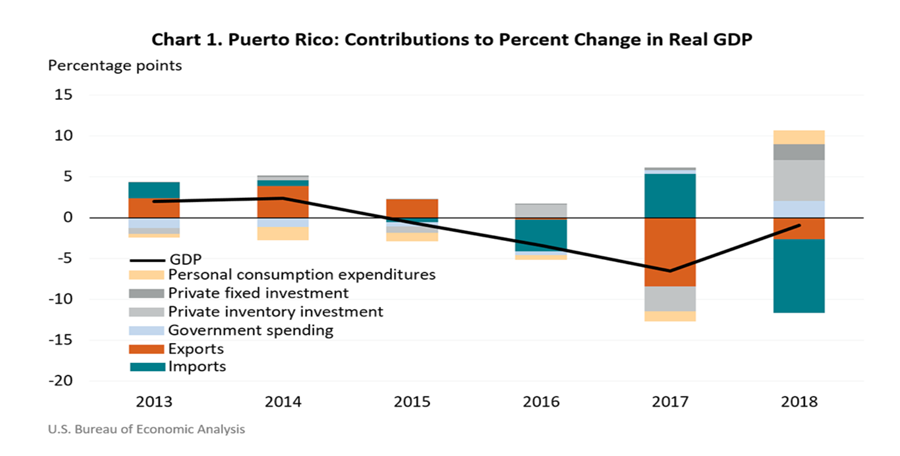Bureau of Economic Analysis releases 1st prototype of GDP estimates for Puerto Rico

The U.S. Department of Commerce’s Bureau of Economic Analysis released prototype annual estimates of gross domestic product (GDP) for Puerto Rico for the years 2012 to 2018, the agency announced.
This publication “represents another major step by the Bureau to develop comprehensive economic accounts for Puerto Rico that are consistent with international guidelines and that are directly comparable to data for other states and countries,” the agency said.
This effort builds on previous work by BEA, published in October 2019, to estimate personal consumption expenditures, private fixed investment, and net exports of goods for Puerto Rico, as this media outlet reported.
In conjunction with this release, BEA is requesting feedback via email to refine the data sources and methods used to prepare these statistics.
The prototype estimates showed that the Puerto Rico economy, as measured by inflation-adjusted (or “real”) GDP, expanded from 2012 to 2014, before turning down in 2015 and continuing to decrease through 2018.
Exports of goods and services was a key contributor to changes in real GDP over this period. Within exports and imports of goods and services, much of the volatility reflected trade in intellectual property (IP) intensive goods, including pharmaceuticals and organic chemicals and medical and scientific equipment and appliances.
In Puerto Rico, subsidiaries of large nonresident multinational enterprises operate within the industries engaged in the manufacturing of the goods listed. To shed light on the impact of their activities on Puerto Rico’s economy, this release includes an analysis of GDP that removes the exports, imports, and inventory investment associated with select IP-intensive industries.
“The statistics released today incorporate the most up-to-date methods and data available to BEA. More information on the methodologies and data sources that underlie the estimates is available in the Summary of Methodologies: Puerto Rico Gross Domestic Product file on BEA’s website.
In its analysis, the agency concluded that the island’s real GDP expanded from 2012 to 2014 before turning down in 2015 and continuing to decrease through 2018. The growth from 2012 to 2014 was more than accounted for by exports, which goods grew significantly in those years, especially pharmaceuticals and organic chemicals and medical and scientific equipment and appliances.
The largest decline in real GDP over the period was in 2017, reflecting the widespread impact of Hurricanes Irma and María on exports of goods, private inventory investment, and personal consumption expenditures — also referred to as consumer spending.
In 2018, real GDP declined 0.9 percent. Although consumer spending, private inventory investment, and construction activity grew significantly in the year after the hurricanes, these increases were offset by an increase in imports, which is a subtraction in the calculation of GDP, and a decrease in exports.
Looking ahead, the agency said it will use the feedback it receives to help improve the data sources and methodologies used in preparing these statistics.
“The estimates released today represent an important step to achieving BEA’s long-term goal: to integrate the U.S. territories into the full set of U.S. National Income and Product Accounts. For Puerto Rico, a primary challenge in realizing this goal is the lack of coverage by most of the major surveys used by BEA to produce estimates of national GDP and related economic measures,” the agency said
“The present methodology relies on currently available data. BEA appreciates the assistance and information provided by the Puerto Rico government,” it added.
BEA also plans to extend and improve the estimates of GDP for Puerto Rico, for which it will finalize methodology and conduct a comprehensive update next year.
“Estimates of GDP will be revised to reflect methodological improvements and the availability of more complete data over time, in some cases back to 2012,” it said.
Information from the Census Bureau’s 2017 Economic Census of Island Areas will be incorporated at that time, the agency added.
BEA is also researching the development of other related measures of economic activity for Puerto Rico, including gross national product (GNP).
“Because of the large presence of multinational enterprises in Puerto Rico, a measure of GNP would be another valuable tool for policy makers to gauge the economic well-being of the Commonwealth’s residents,” it added.
Because Puerto Rico is not included in most of the major surveys used by BEA to estimate U.S. national GDP, it relied on a number of local government agencies, namely: the Economic Development Bank for Puerto Rico, Office of Economic Studies; the Office of the Commissioner of Insurance of Puerto Rico; the Department of Economic Development and Commerce; the Treasury Department; the Puerto Rico Electric Power Authority; the Puerto Rico Industrial Development Company; the Puerto Rico Institute of Statistics; and the Puerto Rico Planning Board.














